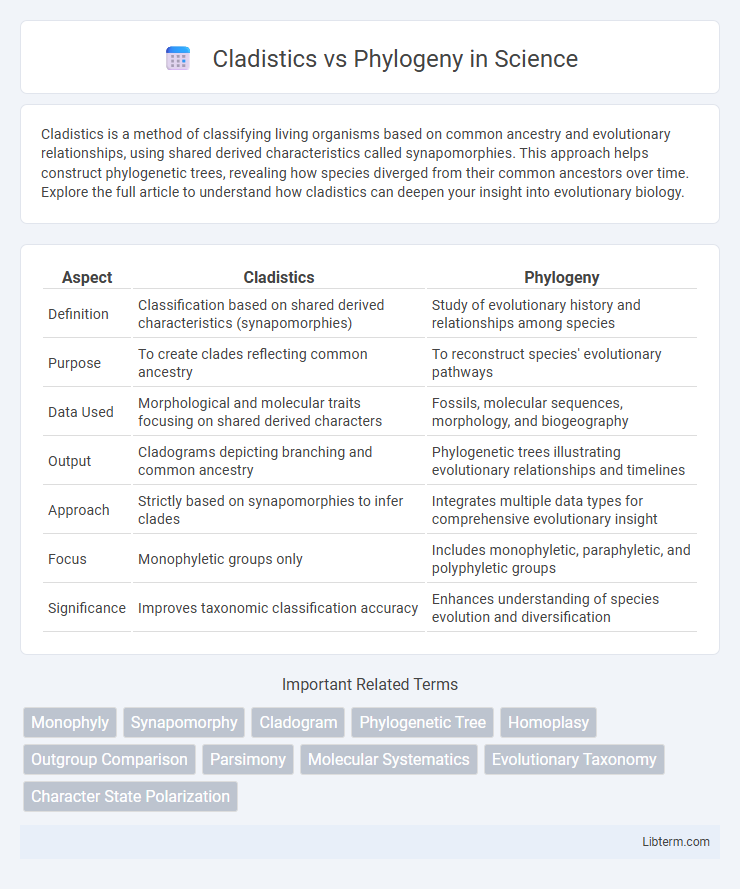Cladistics is a method of classifying living organisms based on common ancestry and evolutionary relationships, using shared derived characteristics called synapomorphies. This approach helps construct phylogenetic trees, revealing how species diverged from their common ancestors over time. Explore the full article to understand how cladistics can deepen your insight into evolutionary biology.
Table of Comparison
| Aspect | Cladistics | Phylogeny |
|---|---|---|
| Definition | Classification based on shared derived characteristics (synapomorphies) | Study of evolutionary history and relationships among species |
| Purpose | To create clades reflecting common ancestry | To reconstruct species' evolutionary pathways |
| Data Used | Morphological and molecular traits focusing on shared derived characters | Fossils, molecular sequences, morphology, and biogeography |
| Output | Cladograms depicting branching and common ancestry | Phylogenetic trees illustrating evolutionary relationships and timelines |
| Approach | Strictly based on synapomorphies to infer clades | Integrates multiple data types for comprehensive evolutionary insight |
| Focus | Monophyletic groups only | Includes monophyletic, paraphyletic, and polyphyletic groups |
| Significance | Improves taxonomic classification accuracy | Enhances understanding of species evolution and diversification |
Introduction to Cladistics and Phylogeny
Cladistics is a method of classifying organisms based on shared derived characteristics that trace evolutionary relationships, producing a branching diagram called a cladogram. Phylogeny involves the study of evolutionary history and relationships among species or groups, often represented by a phylogenetic tree illustrating divergence from common ancestors. While cladistics emphasizes reconstructing order of branching events through synapomorphies, phylogeny encompasses broader evolutionary patterns using molecular, morphological, and genetic data.
Defining Cladistics: Concepts and Methods
Cladistics is a method in biological classification that groups organisms based on shared derived characteristics called synapomorphies, reflecting their evolutionary relationships. It uses cladograms, branching diagrams that represent hypotheses about the sequence of evolutionary events and common ancestry. This approach emphasizes monophyletic groups, which include an ancestor and all its descendants, to ensure accurate depiction of phylogenetic relationships.
Understanding Phylogeny: An Overview
Phylogeny represents the evolutionary history and relationships among species based on common ancestry, depicted through phylogenetic trees. Cladistics is a method used to infer phylogeny by grouping organisms into clades based on shared derived characteristics called synapomorphies. Understanding phylogeny involves analyzing genetic, morphological, and molecular data to reconstruct the branching patterns that reflect evolutionary divergence.
Key Differences Between Cladistics and Phylogeny
Cladistics classifies organisms strictly based on shared derived traits (synapomorphies) to establish evolutionary relationships, focusing on branching patterns called cladograms. Phylogeny represents the evolutionary history and relationships among species, often illustrated with phylogenetic trees incorporating both morphological and molecular data. Key differences lie in cladistics' emphasis on common ancestry through shared innovations versus phylogeny's broader approach, which may include time estimates and evolutionary distance.
Historical Development of Cladistics and Phylogenetic Analysis
The historical development of cladistics began in the mid-20th century with Willi Hennig's introduction of a methodology based on shared derived characteristics (synapomorphies) to infer evolutionary relationships. Phylogenetic analysis evolved alongside, integrating molecular data and computational algorithms to reconstruct evolutionary trees that reflect estimated divergence times and ancestral lineages. Both approaches revolutionized systematics by providing objective frameworks for classifying organisms based on evolutionary history rather than solely morphological similarity.
Techniques Used in Cladistics vs. Phylogeny
Cladistics relies primarily on the analysis of shared derived characteristics (synapomorphies) to construct cladograms that depict evolutionary relationships based on common ancestry. Phylogeny employs a combination of morphological data, molecular sequences, and computational algorithms such as maximum likelihood and Bayesian inference to create phylogenetic trees reflecting evolutionary history. Techniques in cladistics emphasize parsimony analysis to minimize evolutionary changes, whereas phylogenetic methods integrate statistical models for estimating divergence times and lineage branching.
Advantages and Limitations of Cladistics
Cladistics offers a systematic approach to classifying organisms based on shared derived characteristics, providing a clear framework for identifying evolutionary relationships and creating well-supported phylogenetic trees. Its advantages include objectivity through explicit criteria and reproducibility using computational methods, although limitations arise from potential oversimplification of evolutionary processes and challenges in dealing with horizontal gene transfer or convergent evolution. Cladistics may also struggle with incomplete or ambiguous data, which can lead to less resolved or misleading phylogenies compared to more comprehensive methods incorporating genetic and morphological evidence.
Strengths and Drawbacks of Phylogenetic Approaches
Phylogenetic approaches offer a robust framework for understanding evolutionary relationships by reconstructing ancestral lineages using molecular and morphological data, providing detailed insights into species divergence. Strengths include high resolution of evolutionary patterns and compatibility with genetic data, enabling precise tree-building and hypothesis testing. Drawbacks involve potential biases from incomplete or convergent data, computational complexity, and challenges in accurately modeling horizontal gene transfer or rapid radiations.
Applications in Evolutionary Biology
Cladistics provides a systematic method for classifying organisms based on shared derived characteristics, allowing evolutionary biologists to construct accurate cladograms representing ancestral relationships. Phylogeny utilizes molecular data, such as DNA sequences, to infer the evolutionary history and divergence of species, facilitating the study of speciation and adaptive evolution. Together, these approaches enable comprehensive analyses of evolutionary patterns, contributing to biodiversity conservation and the identification of evolutionary significant units.
Future Perspectives: Integrating Cladistics and Phylogeny
Integrating cladistics and phylogeny offers a promising future for evolutionary biology by combining cladistics' rigorous classification based on shared derived traits with phylogeny's detailed evolutionary tree reconstructions. Advances in computational biology and genomic data analysis are enabling more precise phylogenetic models that incorporate cladistic principles, improving the accuracy of species relationships. This integration supports enhanced biodiversity assessments and evolutionary insights through unified methodological frameworks.
Cladistics Infographic

 libterm.com
libterm.com